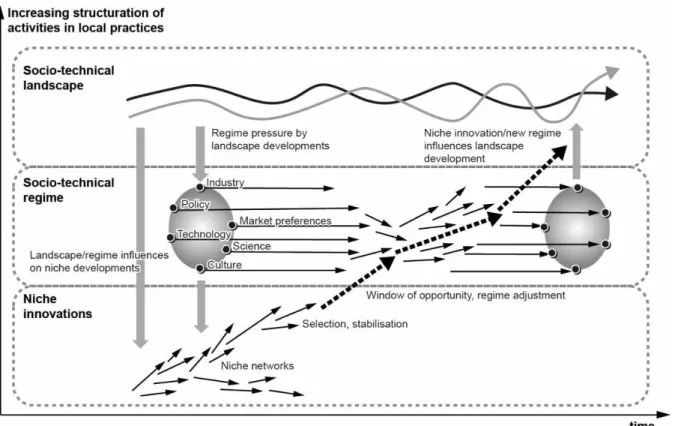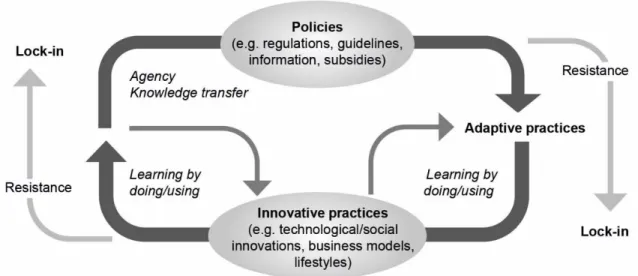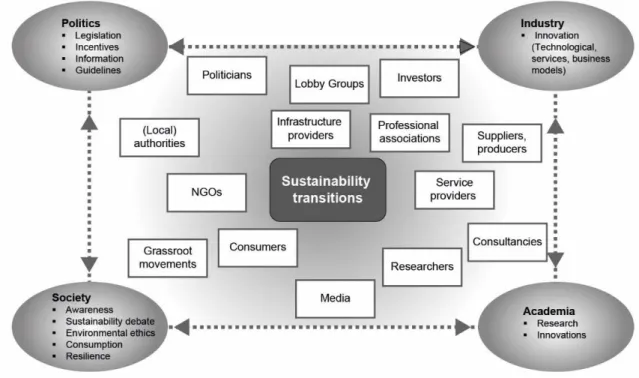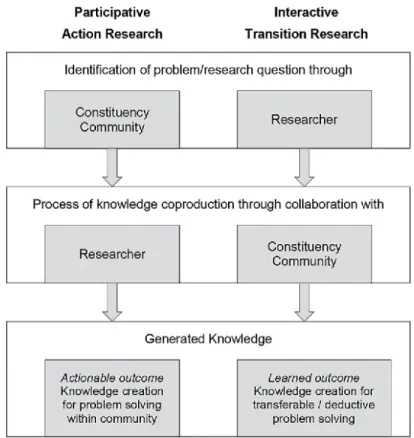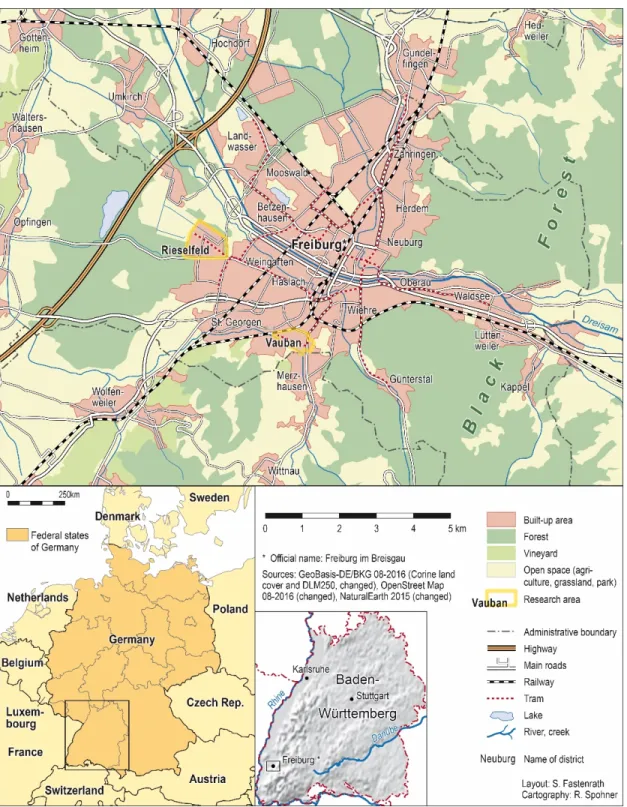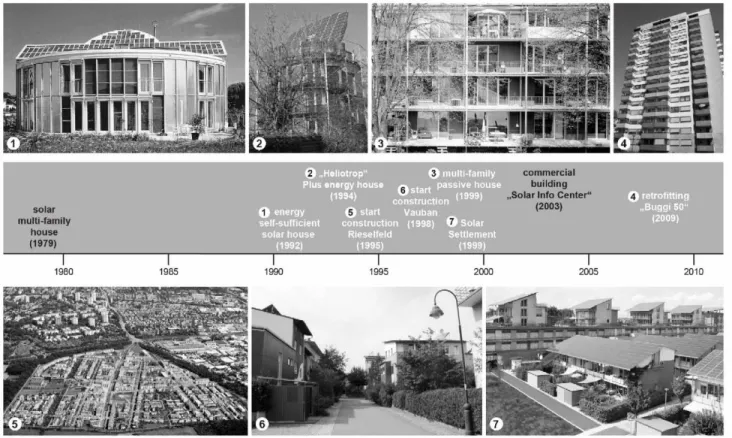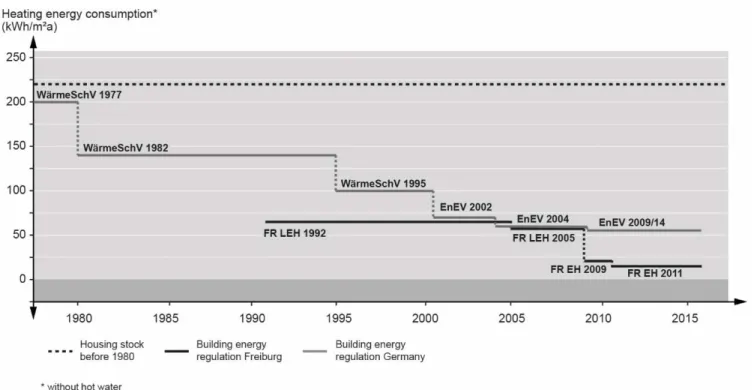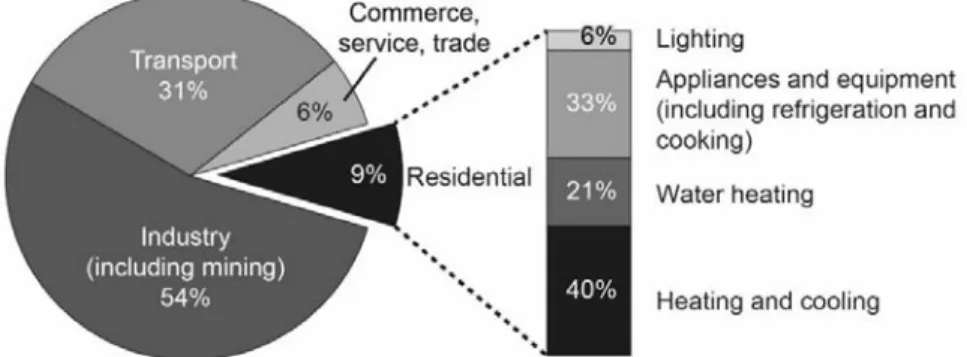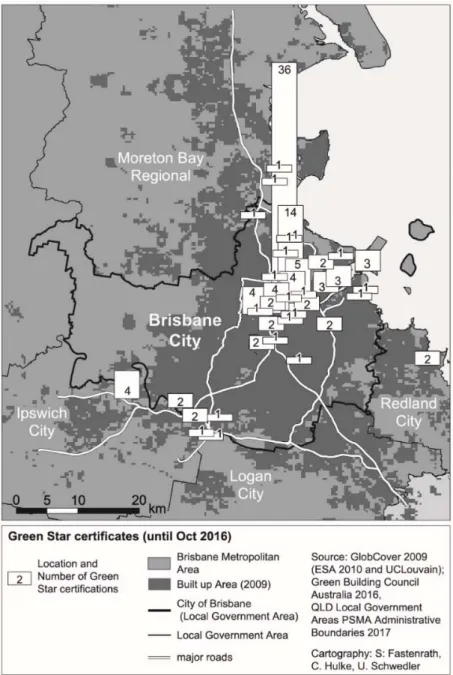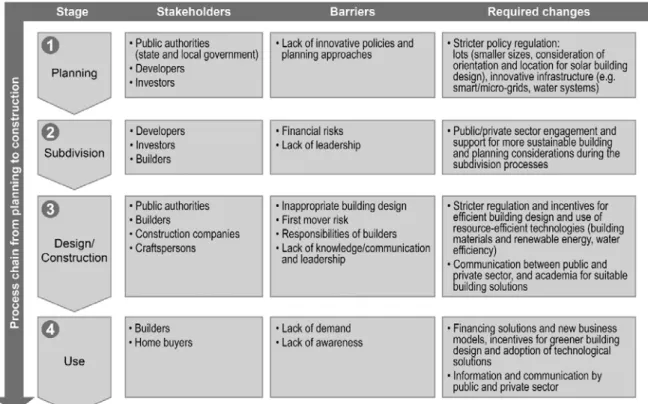Urban Sustainability Transitions in the Building Sector
Insights from contrasting contexts: Freiburg and Brisbane
Inaugural-Dissertation
zur
Erlangung des Doktorgrades
der Mathematisch-Naturwissenschaftlichen Fakultät der Universität zu Köln
vorgelegt von
Dipl.-Geogr. Sebastian Fastenrath aus Remscheid
Köln 2018
Berichterstatter:
Prof. Dr. Boris Braun (Universität zu Köln) Prof. Dr. Javier Revilla Diez (Universität zu Köln) Prof. Dr. Christian Schulz (Université du Luxembourg)
Tag der mündlichen Prüfung: 19.07.2018
i
Acknowledgements
The pathway of my PhD project was an exciting and valuable time period of my life. The work during the last four years shaped me both as a scientist and as a person. I am grateful to my supervisor Prof. Dr. Boris Braun for giving me the opportunity to conduct the PhD project at the Institute of Geography in Cologne. His scientific advice, fruitful discussions and continual support were essential for the success of this PhD thesis. I would also like to thank my other two co‐supervisors Prof. Dr. Javier Revilla Diez and Prof. Dr. Christian Schulz who guided me with valuable advice over the last few years.
I would like to thank the ‘German Research Foundation’ DFG and the ‘Fond National de la Recherche Luxembourg’ which funded the empirical data collection for this dissertation through the CORE‐INTER research project ‘GreenRegio’. GreenRegio was hosted by the Université du Luxembourg and the University of Cologne. Special thanks to Dr. Julia Affolderbach for the excellent project organisation but also for supporting and encouraging me during the whole project time. Thanks also to Bérénice Preller for the fruitful research phases conducted together in Freiburg.
I am also grateful for the financial support by the ‘Graduate School of Geosciences’ GSGS at the Faculty of Mathematics and Natural Sciences at University of Cologne which awarded me with the GSGS’s Fellowship Grant 2016. The Grant was a great support during the final stages of my PhD project. The research stay in Australia during the funding period 2016/2017 as a guest researcher in Brisbane and Sydney was crucial for my PhD project but also for further steps in my academic career. I am particularly grateful to Prof. Dr.
Douglas Baker Queensland University of Technology and Prof. Dr. Bill Pritchard University of Sydney for the great support during my research stays. Australia, and particularly Brisbane became a second home to me during this time.
I would like to thank everyone at the Institute of Geography in Cologne who made these last four years so precious and worthwhile. Special thanks to Carolin Hulke, Katharina Molitor, Marius Reissner, Miriam Schröer, Tanja Ossendorf, Amelie Bernzen, Franziska Sohns, Lisa Bott, Prof. Dr. Peter Dannenberg, Fabian Sonnenburg, Alexander Follmann, Frauke Haensch and Pia Lieske for their support, their interest and encouragement.
Thanks also to Dr. Holger Kretschmer for his support as a member of my GSGS supervision committee. Also many thanks to Ulrike Schwedler und Gine Spohner for their great support in producing figures, tables and maps. Moreover, I would like to thank Prof. Dr.
Stadelbauer i.R. for handing over his impressive collection of newspaper articles and other documents on Freiburg’s urban development since the 1970s.
Crucial to my dissertation were more than 60 experts and stakeholders which were willing to participate in workshops, interviews or handed over valuable documents. My
ii
special thanks are addressed to everyone who helped me in Freiburg and Brisbane who spent valuable time to support this project.
I am extremely grateful to my friends who have followed and guided me through the whole PhD project.
I dedicate this work to my family, who have always supported me at every stage.
iii
Table of contents
Acknowledgements i
List of figures v
List of tables vi
List of abbreviations and acronyms vii
CHAPTER 1: Introduction 1
1.1 Objectives of the dissertation 1
1.2 The case studies 3
1.3 Research questions 5
1.4 Structure of the dissertation 6
CHAPTER 2: Conceptual framework 7
Lost in Transition? Directions for an Economic Geography of Urban Sustainability Transitions
2.1 Introduction 8
2.2 From Evolutionary Economics to a Geography of Sustainability Transitions 10 2.2.1 Economic Geography perspectives on socio-technological change and sustainability 15
2.3 Towards an Economic Geography of Urban Sustainability Transitions 18
2.4 Conclusions 24
2.5 References 27
CHAPTER 3: Methodology 37
3.1 Overview of methodology 37
3.2 Interactive knowledge generation in urban green building transitions 39
3.2.1 Introduction 40
3.2.2 Participatory research and knowledge co-production 41
3.2.3 Co-production in (or for?) green building transitions 44
3.2.4 Knowledge co-production at the coffee table: The World Café approach 48
3.2.5 Discussion and Outlook 52
3.2.6 References 55
CHAPTER 4: Case Study of Freiburg 60
Sustainability transition pathways in the building sector: Energy-efficient building in Freiburg
4.1 Introduction 61
4.1.1 Urban sustainability transition pathways 62
4.1.2 Research questions, research design and data sources 64
4.1.3 The ‘Green City’ Freiburg as a case study 65
4.2 Sustainability transitions in Freiburg’s building sector 67
4.2.1 Initial phase: from grassroots movements to experimental projects (1970-1985) 67
4.2.2 Take-off phase: ‘window of opportunity’ (1986-1992) 69
4.2.3 Rieselfeld: the sustainability transition testbed (1993-2003) 71
iv
4.2.4 Vauban: from low-energy buildings to plus-energy neighbourhood (1998-2003) 74 4.2.5 Transition reversal: ‘Top down’ transitions – the starting shot for a policy-driven path (2004-2007) 76 4.2.6 ‘Green mainstreaming’: strict energy requirements for all new residential building projects (2008-2016) 78 4.2.7 Going too far? Increasing scepticism against over-ambitious building standards 79
4.3 Conclusions 80
4.4 Notes 82
4.5 References 83
CHAPTER 5: Case Study of Brisbane 87
Ambivalent urban sustainability transitions: Insights from Brisbane's building sector
5.1 Introduction 88
5.2 Urban sustainability transitions 89
5.3 Green building transitions 91
5.4 Brisbane as a case study 92
5.5 Methods 94
5.6 Results 96
5.6.1 Early experimental phase (1960s-1980s) 96
5.6.2 Policy path creation and local window of opportunity (1990s) 97
5.6.3 Ambivalent sustainability transitions (2000s) 98
5.6.4 Path disruptions through regime resistance (2010s) 102
5.6.5 Challenges and barriers in the residential building sector 103
5.7 Discussion and conclusions 105
5.8 Acknowledgements 107
5.9 References 108
CHAPTER 6: Concluding discussions 112
6.1 Reflections on the case study of Freiburg 113
6.2 Reflections on the case study of Brisbane 114
6.3 Reflections on the methodological approaches 117
6.4 Limitations 117
6.5 Policy implications 118
6.6 Outlook for further urban sustainability transition research 119
6.7 References (Chapters 1, 3, 6) 121
SUMMARY 123
APPENDIX A: Interview guidelines 126
APPENDIX B: Interviews, case studies of Freiburg and Brisbane 128
APPENDIX C: Coding categories 130
APPENDIX D: Report GreenRegio Workshop, Freiburg and Brisbane 132
APPENDIX E: Own contributions made to publications 150
APPENDIX F: Eigenständigkeitserklärung 152
v
List of figures
Figure 2.1: The Multi-Level Perspective 13
Figure 2.2: Path creation theory 17
Figure 2.3: Sustainability Transitions dynamics 21
Figure 2.4: Practice change in sustainability transitions 22
Figure 2.5: Key actors in urban sustainability transitions 23
Figure 3.1: Final workshop in Freiburg 38
Figure 3.2: Imperatives and objectives in participative research and interactive transition research 47
Figure 4.1: The geographical context of Freiburg 66
Figure 4.2: Key building projects in Freiburg 68
Figure 4.3: Pathways of building energy regulation in Germany and Freiburg 71
Figure 4.4: The Rieselfeld district 72
Figure 4.5: Realised building energy standards in the Vauban district 75 Figure 4.6: Governance pathways in the building sector: EU, German federal government and City of 77 Freiburg
Figure 5.1: Energy consumption in Australia by main sectors (left) and the residential sector (right) 91 in 2013
Figure 5.2: Greater Brisbane, administrative and statistical boundaries 93 Figure 5.3: Green Star certificates (4, 5 and 6 stars) in the City of Brisbane 2005-2015 100 Figure 5.4: Locations of Green Star certified projects in Brisbane 101 Figure 5.5: Process chain of residential buildings in master-planned communities 103
vi
List of tables
Table 3.1: Composition and themes of research project’s World Cafe workshops 51
Table 5.1: Overview of interviews 95
vii
List of abbreviations and acronyms
ABS: Australian Bureau of Statistics
AGDF: Australian Green Development Forum BCA: Building Code Australia
BCC: Brisbane City Council CBD: Central Business District
COAG: Council of Australian Governments
EnEV: Energieeinsparverordnung (Energy Saving Ordinance) EU: European Union
FR EH: Freiburg Energy House FR LEH: Freiburg Low-Energy House GBCA: Australian Green Building Council GFC: Global Financial Crisis
HeizAnlV: Heizungsanlagen-Verordnung (Heating Systems Ordinance) HIA: Housing Industry Association
IEA: International Energy Agency
IPCC: Intergovernmental Panel on Climate Change ISES: International Solar Energy Society
KfW: Kreditanstalt für Wiederaufbau (German Development Bank) LGA: Local Government Area
NABERS: National Australian Built Environment Rating System NatHERS: Nationwide House Energy Rating Scheme
NCC: National Construction Code
OECD: Organisation for Economic Co-operation and Development PCA: Property Council of Australia
QDC: Queensland Development Code QLD Gov: Queensland State Government SEQ: South East Queensland
UDIA: Urban Development Institute of Australia UN: United Nations
UNEP: United Nations Environment Programme UQ: University of Queensland
WärmeSchV: Wärmeschutzverordnung (Thermal Insulation Ordinance) WBGU: Wissenschaftlicher Beirat der Bundesregierung
1
1
CHAPTER 1: Introduction
During the last few years, transformations towards more sustainable modes of production and consumption became a key societal issue. Actions towards climate change mitigation and low‐carbon economies have been discussed across academic disciplines and politics.
International organisations such as the United Nations UN , the Intergovernmental Panel on Climate Change IPCC and independent scientific advisory boards have articulated the need for significant socio‐economic shifts to face challenges of environmental degradation, global warming and the growing demand for fossil energy sources e.g. German Advisory Council on Global Change WBGU , 2016 . Against this backdrop of the urgent need for actions to initiate change to mitigate greenhouse gas emissions, support renewable energy and new economic practices, the urban context has been identified as significant Bulkeley et al., 2011; Frantzeskaki et al., 2017; Moore et al., 2018 .
Cities are more and more understood as the key arenas and seedbeds to initiate actions for sustainability transitions towards systemic low‐carbon transitions in fields such as energy, food, waste, mobility, housing and urban green. Cities and their institutional contexts continually influence urban development processes through planning guidelines and mechanisms, funding and incentives. Academic, political and private sectors are increasingly looking for applicable low‐carbon solutions and meaningful policy recommendations in city contexts. There is agreement that new forms of collaboration between a wide range of stakeholders is needed to activate the ‘transformative power’ of cities, and catalyse innovative and context‐specific approaches WBGU, 2016 . Therefore, an understanding of best practices in sustainable forerunner cities – but, also processes of resistance in ‘lagger’ cities – has high relevance in academia and policy‐making.
To deliver policy recommendations, the great challenge is to develop a broader understanding of complexity and patterns of socio‐technical transitions in city contexts.
Urban sustainability transitions are the result of a combination of technological innovations, political interventions and socio‐economic practices. These shifts are non‐
linear co‐evolutionary processes that usually develop over longer time periods, typically over two or three decades Geels, 2002 . Since the early 2000s, research on socio‐technical change in the sustainability context has been conducted in the research area of Transition Studies e.g. Berkhout et al., 2004; Elzen et al., 2004; Geels, 2002; Kemp and Rotmans, 2004 . However, questions of spatiality, temporality, and how economic and socio‐political processes interact have been largely neglected in transition research Coenen et al., 2015;
Gibbs and O’Neill, 2017 . Explanations are lacking as to why transition dynamics vary in
2
1
different spatial contexts. New perspectives are required to gain further knowledge about how sustainability transitions are embedded in specific spatiotemporal contexts Murphy, 2015 . Particularly, the dynamic interplay of changed practices, socio‐political processes and related driving and resisting actors needs further attention. Surprisingly, geographical concepts have been widely neglected to conceptualise urban sustainability transitions, even though the lack of socio‐spatial contextualisation has been articulated by a number of scholars Binz et al., 2014; Coenen and Truffer, 2012; Geels, 2012; Truffer et al., 2015 .
The potentials of bringing together approaches of Transition Studies and Geography have been considered in literature that can be framed as the ‘Geography of Sustainability Transitions’ Hansen and Coenen, 2015; Murphy, 2015 . Scholars have emphasised the importance of a relational understanding of space, and the understanding in how actors, networks, grassroots movements and policies are embedded in sustainability transition processes. Concurrently, other contributions focus on the role of changed socio‐economic practices in the context of environmental technologies Faller, 2016; Faller and Schulz, 2017 . These theoretical thoughts outline a new geographical research agenda beyond the framework of the much‐noticed ‘Multi‐level perspective’ MLP in Transition Studies Geels, 2002 . This dissertation draws on these conceptual approaches and seeks to further develop the conceptual debate by bridging approaches of Economic Geography, which traditionally consider the interplay of economic development and innovations in temporal and spatial settings.
The built environment has largely been neglected in sustainability transition research, even though buildings are significant contributors to human‐related greenhouse gas emissions IPCC, 2014 . Transitions from conventional towards resource‐efficient modes of building and construction are playing an increasingly important role in international public debates on climate change and resource efficiency United Nations Environment Programme UNEP , 2014 . At the highest international levels, the crucial role of a greener built environment and related policy support is discussed in the context of urban and regional climate change adaptation strategies UNEP, 2014 . While there are diverse definitions, green building is generally understood as the alternative practice of creating resource‐
efficient and healthier approaches for building design, construction, renovation, operation and maintenance. The key goal of a broader implementation of ‘green’ architectural principles e.g. solar, passive or low‐energy design and ‘low‐carbon’ building technologies and materials is reducing energy consumption and greenhouse gas emissions in buildings IPCC, 2007; UNEP, 2011 . Energy‐efficient building concepts such as solar‐, passive‐ or low‐energy design receive a lot of attention and are more common. Why green building principles are adapted unequally in different city contexts is widely unknown.
3
1
1.1 Objectives of the dissertation
The key objectives of this dissertation are the development of a wider understanding of processes and dynamics of urban sustainability transition by, first, developing new conceptual approaches and, then, providing in‐depth empirical insights of sustainability transitions in the building sector using the two contrasting case studies: Freiburg
Germany and Brisbane Australia .
Why and how green building transitions occur and develop unequally from city to city is the overarching question of this dissertation. The key goal is to trace back the context‐
specific key pathways in the cities’ building sectors and, thus, develop a further understanding of successful transitions and processes of resistance. The core of the case study analysis focuses on the identification and the analyses of the dynamic interplay of building practices, governance processes and actors. To understand the driving and resisting processes, the involved actors – and, therefore, the directions of change and resistance – is key to adding knowledge to the debates around spatial and temporal aspects in urban sustainability transitions. Drawing on the premise that ‘history matters’ in explaining current processes in city contexts, an important goal of the dissertation is to trace processes of change at different historical stages and phases. The understanding of city contexts as non‐static but highly dynamic and ongoing is increasingly important for city researchers as well as policy‐makers who can influence processes of change through planning guidelines, incentives or regulation.
Therefore, this dissertation seeks to add knowledge to the debates around spatio‐temporal aspects in urban sustainability transitions by tracing back the pathways of ‘green building’
in the contrasting city contexts. The main goal is to identify and analyse the following research entities and their interplay:
changes in building and construction practice
driving and resisting actors
the institutional influence policy decisions, including regulation, guidelines, planning mechanisms
directions of transitions grassroots movement ‘bottom up’ or policy ‘top down’ .
1.2 The case studies
The two contrasting city contexts provide the unique opportunity to unpack and understand ‘success factors’ on one hand and processes of resistance on the other hand.
While the ‘green’ forerunner city Freiburg has experienced significant shifts from
4
1
conventional building practices towards ‘low‐energy’ and ‘passive houses’ building concepts, Brisbane can be understood as a sustainability ‘lagger’ in the building sector.
Freiburg
Located in the south‐west of Germany at the edge of the Black Forest, and with a population of about 230,000, Freiburg has received numerous awards for its environmental initiatives in urban sustainability and environment during the last decades. As a result, academic contributions have been published on Freiburg’s various urban transition processes in transport, urban planning, waste management, and energy efficiency e.g. Hall, 2014; Späth
& Ornetzeder, 2017; Späth & Rohracher, 2011 . Even though green building is a key characterictic of Freiburg’s image as a green city, a detailed analysis of the city’s green building pathways is lacking in the literature.
The case study of green building transitions in Freiburg gives the opportunity to analyse long‐term urban transition pathways. The origins of green building in Freiburg can be traced to the 1970s, when innovative architects and engineers started niche experiments.
In the early 1990s, the city of Freiburg introduced and incrementally improved low‐energy requirements for new buildings on city‐owned properties – a process that was largly supported by a wide range of actors. After continual policy support through the 2000s, all new building projects in Freiburg have had to reach strict requirements which almost meet the ‘passive house’ standard.
How these socio‐technical transitions were driven from a bottom‐up grassroots movement towards a top‐down policy process is the core of the case study analysis. Tracing the city’s long‐term evolution and different phases of green building practices and the interrelations with urban goverance processes allows the identification of the main drivers, directions, negotiation processes and learning processes technological and institutional within the city’s pathways.
Brisbane
The contrasting city context of Brisbane provides the opportunity to explore challenges and resistance in green building pathways.
With a population of about 2.3 million, Brisbane is Australia’s third‐largest metropolitain area, the capital of Queensland and the administrative centre of the Brisbane City Council
5
1
and the Queensland State Government. In contrast to Freiburg, Brisbane’s history of green building is comparably short and characterised by discontinuity, lock‐ins and resistance.
Even though knowledge of energy‐efficient building design has been gained since the 1960s in Brisbane’s academic sphere, alternative building practices never became common practice in the building and construction industry, nor a key topic in the public sector.
Therefore, the Brisbane case study provided valuable insights into a sustainability latecomer city and its ambivalent sustainability transition processes. Tracing the processes and drivers in the residential and commercial building sector can provide insights into the roles of the public and private sector.
1.3 Research questions
A number of questions need to be answered to further understand the role of spatial contexts and temporality in sustainability transitions: When, where, why and how do transitions happen? What explains the diverging development of changed practices towards sustainability from place to place? Why are there forerunner places with significant shifts towards new socio‐technical structures while there are also places that are lagging? What are the context‐specific conditions and pathways that lead to change or resistance?
To find explanations for successful and challenging green building pathways, including interactions between technological and institutional‐political logics, this dissertation seeks to find answers for the following key research questions:
1 What are significant shifts in the context of green building e.g. building projects, policies, economics ?
2 In the case study contexts, who are the driving actors or resisting actors in the building sector?
3 To which extend do policy‐making processes play a role in driving transitions in the local building sector?
4 What were important learning processes / processes of resistance within the transition pathways?
To gain in‐depth knowledge about the processes over time, and involved actors and their interests in the context of both cities’ green building pathways, this dissertation is conceptualised as a qualitative research design. The empirical data used for this dissertation is based on expert/stakeholder workshops, document analysis and expert/stakeholder interviews.
6
1
1.4 Structure of the dissertation
This dissertation is based on four journal articles which are integrated in the following five chapters. Chapter 2 outlines the theoretical and conceptual background of this dissertation based on the journal article “Lost in Transition? Directions for an Economic Geography of Urban Sustainability Transitions”. Chapter 3 presents the methodological approaches, with a focus on interactive learning processes through expert/stakeholder workshops. This approach is explained through the publication “Interactive knowledge generation in urban green building transitions”. The case study research is provided in Chapters 4 and 5. Based on the article “Sustainability transition pathways in the building sector: Energy‐efficient building in Freiburg Germany ”, Chapter 4 outlines the context in Freiburg, and focuses on success factors of urban green building transitions. Chapter 5 is based on the article
“Ambivalent urban sustainability transitions: Insights from Brisbane’s building sector”, which discusses the processes of resistance in the urban context of Brisbane. Finally, Chapter 6 concludes this dissertation by discussing the results and providing an outlook in further research opportunities.
7
2
CHAPTER 2: Conceptual Framework
Lost in Transition? Directions for an Economic Geography of Urban Sustainability Transitions.
Fastenrath, S. & Braun, B.: Lost in Transition? Directions for an Economic Geography of Urban Sustainability Transitions.
With kind permission by MDPI.
This paper is under review in ‘Sustainability‘.
Abstract
Socio‐technical transitions towards more sustainable modes of production and consumption are receiving increasing attention in the academic world and also from political and economic decision‐makers. There is increasing demand for resource‐
efficient technologies and institutional innovations, particularly at the city level. However, it is widely unclear how processes of change evolve and develop and how they are embedded in different socio‐spatial contexts. While numerous scholars have contributed to the vibrant research field around sustainability transitions, the geographical expertise largely has been ignored. The lack of knowledge about the role of spatial contexts, learning processes and the co‐evolution of technological, economical and socio‐political processes has been prominently addressed. Bridging approaches from Transition Studies and perspectives of Economic Geography, we present conceptual ideas for an evolutionary and relational understanding of urban sustainability transitions. The paper introduces new perspectives on sustainability transitions towards a better understanding of socio‐
spatial contexts.
8
2
2.1 Introduction
Socio‐technical change in the sustainability context is increasingly receiving attention from a wide range of academic disciplines but also from public and private sectors.
Cleaner and resource‐efficient technologies and practices are required in contexts such as energy, transport, waste recycling, green space, agriculture, housing and construction.
Within the debates about alternative modes of production and consumption, cities are understood as the key arenas for socio‐technical change Avelino & Wittmayer, 2017;
Bulkeley, Castán Broto, & Maassen, 2011; Frantzeskaki et al., 2017b; WBGU, 2016 . However, how sustainability transitions occur and develop, and how they are interrelated to economic and socio‐political processes, is widely unclear Coenen et al., 2015; Gibbs &
O’Neill, 2017 . A number of questions need to be answered to further understand spatiality and temporality in sustainability transitions: When, where, why and how do transitions happen? Why are there forerunner places with significant shifts towards new socio‐technical structures while other places lag behind? What are the conditions and pathways that lead to change or resistance? What or who are the drivers and detractors?
New analytical perspectives and conceptual approaches are required to gain further knowledge about how the dynamics of sustainability transitions are embedded in specific spatiotemporal contexts Murphy, 2015 . A special focus needs to be drawn on the dynamic interplay of practices, institutional processes and related driving and hindering actors. It is surprising that geographical concepts largely have been neglected in transition research, even though the lack of socio‐spatial contextualization has been acknowledged by a number of scholars Binz et al., 2014; Coenen & Truffer, 2012; Geels, 2012; Truffer et al., 2015 . The introduction of ideas for a ‘Geography of Sustainability Transitions’ Hansen & Coenen, 2015; Murphy, 2015; Truffer & Coenen, 2012; Truffer et al., 2015 was an important first step towards an analysis of the contextualization of transitions. These articulated theoretical thoughts outlined a geographical research agenda beyond the vibrantly used heuristic framework of the ‘Multi‐level perspective’
MLP in Transition Studies Geels, 2002 .
This paper aims to develop conceptual ideas considering economic geographic perspectives to overcome the “ … naïve conceptualization of space, scale and power”
Truffer & Coenen, 2012, p. 15 in sustainability transition research. As various scholars suggest, combining approaches from Economic Geography and Transition Studies TS helps to understand and analyse socio‐technical change and its embeddedness in socio‐
spatial structures e.g. Boschma et al., 2017; Coenen et al., 2015; Truffer, 2008; Truffer &
Coenen, 2012 . Both heterogeneous research fields share a common understanding of
9
2
path dependencies, thinking of continuity of change, and the influence of institutional contexts.
Economic Geography concepts with an evolutionary and relational understanding of economic development e.g. Jones, 2009 are most suitable to link these concepts.
Nevertheless, these approaches need a more practice‐ and institutional oriented research focus in the sustainability transitions context. Jones and Murphy 2011, p. 371 argue that the focus on practices can “provide a grounded theoretical lens for understanding how a diverse range of processes and phenomena e.g. learning, networks, governance, development, livelihood strategies occur, evolve, and/or become transformed over time and in space”. Moreover, a growing number of contributions emphasize the important role of actors and actor networks, grassroots movements and policy‐makers as key drivers behind sustainability transition. Truffer and Coenen 2012, p. 15 refer to examples showing that “cities and regions can become powerful promoters of sustainability transitions when understood as relationally embedded actors and providing crucial resources for successful innovation processes”. During the last few years, scholars have demonstrated empirical research on how pioneering socio‐economic practices are driving environmental technologies e.g. Faller, 2016; Faller & Schulz, 2017;
Fastenrath & Braun, 2018 .
The aim of this contribution is to shed light on urban sustainability transitions by bringing together approaches from Transition Studies and Economic Geography. In section 2, we trace the common grounds of both research fields in understanding and exploring socio‐
technical change before the paper will explore the distinctive nature of sustainability transitions. Economic Geography perspectives in the context of investigating sustainability transitions are discussed in section 2.1. In section 2.3, the paper presents conceptual ideas for analysing changed practices and related drivers and processes in urban sustainability transition processes. Section 2.4 provides concluding thoughts.
10
2
2.2 From Evolutionary Economics to a Geography of Sustainability Transitions
For more than two decades, research on socio‐technical transitions has been conducted in the field of social study of technology SST , better known as ‘transition studies’. This popular multi‐disciplinary research field has brought together insights from economics, innovation and technology studies, history, and social and political sciences. Scholars of transition studies particularly focus on a systemic understanding of technological change as a co‐evolution of technologies but also of policies, user patterns, infrastructures and cultural discourses Geels, 2012 . Similar to approaches of ‘Evolutionary Economic Geography’ and ‘Geographies of Innovation’, the roots and central conceptual ideas go back to Evolutionary Economics Dosi, 1982; Nelson & Winter, 1982 . Evolutionary Economics emerged as an alternative conceptual idea to the static neoclassical, orthodox concepts of economic and technological change. The main goal of scholars at that time was to develop an “ … evolutionary viewpoint as a possible framework for a more realistic economic theory of firm and industry behaviour” Nelson & Winter, 1982, p. vii . Evolutionary Economists started to develop a more precise understanding of technological change and interrelated processes and mechanisms by which economies develop. A key idea was to trace past economic and other related processes to better understand current economic dynamics – in other words, ‘history matters’. Similarly, the Economic Geographers Lloyd and Dicken 1977, p. 238 stated that “the economic landscape is the cumulative expression of decisions made at different points in time and under a variety of conditions”.
Nelson and Winter 1982 introduced a new thinking about the drivers of innovation, technological change and decision‐making processes. The authors explicitly responded to the lack of institutional and political considerations in economic research at that time.
They argued that informal institutions, actors single and groups , and policies are crucial factors for economic development. Moreover, they stated that “public law, policies, and organizations are an important part of the environment that shapes the evolution of private sector activities” Nelson & Winter, 1982, p. 371 . Based on a case study from the United States, Nelson and Winter explained their conclusions. By tracing back air quality regulations on different policy levels and interrelated changed economic practices from the 1950s to the 1970s, they emphasised the interactions between industry actors, policies and public administration. Reviewing this case study, Nelson and Winter stated that public policies also tend to follow certain trajectories. They argued that “policy
11
2
changes today might fruitfully be understood as evolving from a policy base that was itself the outcome of a sequence of earlier changes, and, in turn, as setting the stages for future evolutionary developments” Nelson & Winter, 1982, p. 376 . Since then, the understanding of economic development has been based on the assumption that economic action is embedded in institutional and social structures Giddens, 1984;
Granovetter, 1985 . Concepts and empirical research of systems of innovation and technological change occurred Dosi et al., 1988; Freeman, 1995; Lundvall, 1992 . Scholars started to examine the interrelations between technological trajectories and institutional coordination.
The heterogeneous field of ‘Transition Studies’ occurred with a more technological focus Geels, 2002; Kemp, 1994; Kemp et al., 1998; Rip & Kemp, 1998 . Transitions are understood as socio‐technical changes resulting in technological change that is socially embedded and follow certain pathways. Theoretical ideas are based on the premise that technological change is the result of the interactions of co‐evolutionary and non‐linear processes between a wide range of economic, socio‐cultural, political and institutional spheres Geels, 2012; Kemp et al., 1998 . New products, services, business models, organisations completely or partly substitute existing ones Grin et al., 2010 . These interrelations are demonstrated in a number of historical and more recent examples such as shifts from sailing to steaming ship Geels, 2002 , from horse‐drawn carriage to automobiles Geels, 2005 , or from cesspool to sewer systems Geels, 2006 . However, space and location have not been considered explicitly in the theoretical and empirical approaches in Transition Studies.
Sustainability Transitions
Since the 2000s, publications in Transition Studies are increasingly focused on socio‐
technological change in the environmental and sustainability context Kemp & Rotmans, 2004; Smith, 2007; Smith et al., 2005 . While there are various understandings, Markard et al. 2012, p. 955 define sustainability transitions as “transformations towards more sustainable modes of production and consumption”. The goal of scholars in this research context is to understand shifts in the heterogeneous field known under different terms such as eco‐innovations, green‐, environment‐, or clean technologies Geels, 2011; Grin et al., 2010; Markard et al., 2012; Smith et al., 2010 . Socio‐technical processes have been addressed in a wide range of research areas such as renewable energy, agriculture, transport, waste recycling, water supply, and building and construction.
12
2
The major difference of sustainability transitions compared to conventional socio‐
technical transitions is the strong influence by a number of political, scientific and civil societal actors Grin et al., 2010 . Sustainability transitions are not solely economic or technology driven; they must be interpreted as the result of incremental socio‐spatial dynamics influenced by normative expectations Grin et al., 2010; Shove & Walker, 2007 . Cooke 2010 identified a ‘green turn’ in innovation systems which is strongly driven by policies and societal powers. Policies regulations, guidelines, incentives are identified as important drivers for sustainability transitions. Also, Truffer and Coenen 2012, p. 12 argued that “sustainability transitions are by their very nature political projects”.
Therefore, innovative technologies and practices are increasingly understood and conceptualized as niche developments in ‘protective spaces’ where pioneers can experiment and learn under policy and societal protection Smith & Raven, 2012 . Transitions in the sustainability context are progressively understood as highly embedded processes in specific socio‐spatial contexts of places, regions or cities Truffer et al., 2015 . Urban case studies demonstrate how context‐specific pathways of institutions, economic practices, political mechanisms, and driving and hindering actors influence the dynamics of sustainability transitions Fastenrath & Braun, 2018 . New technologies, lifestyles, economic practices, or policies can occur as a result of these processes Truffer et al., 2015 .
The Multi-level perspective
The most recognised concept and theoretical idea to explore phenomena in the field of socio‐technological change is the Multi‐level perspective MLP e.g. Geels, 2002; Geels, 2011 see fig. 2.1 . The MLP “provides an overall view of the multi‐dimensional complexity of changes in socio‐technical systems” Geels, 2010, p. 495 . This heuristic framework was established to develop an understanding of long‐term transition processes by explaining key processes and drivers behind socio‐technical change. In the MLP, understanding transitions happens as a result of co‐evolutionary interactions between three analytical levels Geels, 2002 : 1 A niche level, where innovations occur and build up momentum; 2 a socio‐technical regime level where established structures and networks of actors, institutions and economic practices become stabilised over time;
and 3 a landscape level, the wider context where large influencing factors such as global discourses occur Geels, 2002 .
13
2
Figure 2.1: The Multi‐level perspective own figure
The most important level in the MLP framework is the niche level. Geels explains niches as ‘protected spaces’ where radical innovations, pioneer projects and learning processes occur. These can result in new, stable socio‐technical configurations at the regime level when powerful actors and networks accept these niche developments. The regime concept is understood as an interpretive analytical concept. While the analytical concept of the socio‐technical system “refers to tangible and measurable elements”
Geels, 2012, p. 473 e.g. market shares, regulations, consumption patterns , the regime is understood as a more intangible analytical entity. The socio‐technical regime refers to the rules and routines in which actors are embedded and on which draw concrete actions.
However, as Smith et al. 2010, p. 436 argued, “this attractive big picture is not without its challenges”. A general critical debate about the MLP framework occurred for a number of reasons Shove & Walker, 2007 . A core critique is the fuzzy heuristic and interpretative character and, therefore, empirical limitations. Apart from that, a general debate exists on epistemological aspects and the challenges in operationalizing concrete research objectives Fuenfschilling & Truffer, 2014; Maassen, 2012; Markard & Truffer,
14
2
2008; Shove & Walker, 2007; Smith et al., 2010; Truffer, 2008 ; a number of those aspects are related to the sustainability context.
The dominant ‘technocratic’ understanding of innovation and of the niche‐driven directions have been critically discussed Geels, 2011; Smith et al., 2010; Truffer &
Coenen, 2012 . There is growing evidence that the normative character and the strong public interest in sustainability issues strongly leads to different logics of socio‐
technological and economic change. Thus, there is a need for a closer look at established policy and economic structures as drivers for change but also as detractors Geels, 2014 . While most studies explore successful green niche innovations, processes and actors at the regime level have been neglected. Concepts to operationalize regime‐niche interactions are required to identify drivers, policy structures and power constellations Smith et al., 2005 . Therefore, it is crucial to gain knowledge about successful but also failed or distracted sustainability transitions. Institutional and economic path dependencies, interest structures, driving and hindering actors need to be identified. The dynamics and interactions within the regime but also between niche and regime require more scientific attention. This knowledge is critical to provide recommendations for policy‐makers and industry actors WBGU, 2011 .
Scholars agree that exploring the socio‐spatial and temporal contextualisation can help to better understand these interrelations Geels, 2012; Hansen & Coenen, 2015 . However, concepts in Transition Studies that offer a distinctive spatial perspective are still lacking.
Perspectives of Economic Geography are predestined to add knowledge to how technological innovations, changed economic practices and processes are embedded in social, political and wider economic structures at different times Bathelt & Glückler, 2012 .
Bringing together viewpoints from Evolutionary Economic Geography e.g. Boschma &
Martin, 2010 , Geography of Innovation e.g. Asheim & Gertler, 2005 and Environmental Economic Geography e.g. Braun, 2002; Braun et al., 2003; Patchell & Hayter, 2013; Soyez
& Schulz, 2008 is valuable for developing new theoretical and conceptual approaches for sustainability‐oriented transition research. We agree with Murphy who stated that the geographical perspective helps to “understand the development trajectories of cities, industries, production networks, and economies” Murphy, 2015, p. 73 .
15
2
2.2.1 Economic Geography perspectives on socio-technological change and sustainability
Since the 1990s, Economic Geographers and scholars from related disciplines enrich the debates on technological change with socio‐spatial and evolutionary aspects Amin, 1999;
Morgan, 1997; Storper, 1997; Storper & Scott, 1995 . These scholars developed a more socio‐spatial understanding of economic development and, therefore, can be seen as the originators of an “evolutionary school of technological change” Hassink & Shin, 2005, p.
571 . Considering a relational and evolutionary approach of technological change, researchers explore path dependencies and learning processes within economic structures, predominantly in industrial production systems at the firm level Amin &
Thrift, 2000; Boschma & Lambooy, 1999; Maskell & Malmberg, 1999 . Concepts such as
‘innovative milieus’ Camagni, 1995 and ‘clusters’ Porter, 1990 highlight the role of spatial contexts in innovation processes. In Economic Geography, institutions are increasingly understood as “central to the socio‐cultural construction of the economic”
Martin, 2003, p. 77 . The proximity of actors, embedded learning processes and institutional interactions have been identified as important drivers for innovation
Bathelt et al., 2004 .
Many scholars agree that technological innovations are influenced by interactions within innovation systems Revilla Diez & Kiese, 2009 . Technological change and the interplay with institutions and organisational structures have been explored for systems at different spatial scales. Apart from ‘national innovation systems’ Nelson, 1992 , the concept of ‘regional innovation systems’ particularly has been conceptualized and empirically analysed Asheim & Gertler, 2006; Asheim & Isaksen, 2002; Asheim & Coenen, 2005; Asheim & Smith, 2011; Cooke, 2008; Cooke et al., 1997 . Regional innovation systems are understood as “economic and social interactions between agents, spanning the public and private sectors to engender and diffuse innovation within regions embedded in wider national and global systems” Asheim & Smith, 2011, p. 878 .
Synchronously, scholars within the broader field of ‘Environmental Economic Geography’
EEG contributed to the debate around technological innovations, environmental protection, institutions and knowledge creation Braun, 2003, 2005; Braun et al., 2003;
Gibbs, 2006; Gibbs & Healey, 1997; Hayter, 2008; Hayter & Le Heron, 2002a; Patchell &
Hayter, 2013; Schulz, 2002, 2005; Soyez, 2002; Soyez & Schulz, 2008; Taylor, 1996 . Conceptual and empirical approaches in EEG highlighted the important role of non‐
economic actors and drivers of ‘greening’ processes of firms, production networks, and industry sectors. The special context of green, eco, environmental or sustainability
16
2
innovations and the contextual interplay of regulation and industrial‐environmental processes towards sustainability actions have been explored.
Hayter and Le Heron 2002b argued that ‘green‐facilitative institutions’ are likely to have different spatialities and temporalities compared to established institutions. The authors predicted a “transition from narrow economic and profit oriented technological focus to one that resolutely incorporates green dimensions in technological change” Hayter & Le Heron, 2002b, p. 401 . However, socio‐political perspectives and the interplay of economic and institutional processes in eco‐innovation research are still missing and have been continually articulated Coenen et al., 2015; Fastenrath & Braun, 2018; Gibbs
& O’Neill, 2017; Smith et al., 2010; Strambach & Pflitsch, 2017 . The important role of EEG in sustainable development research and as an important emerging field in Economic Geography was emphasised by Aoyama et al. 2011 .
Parallel to these ideas towards an Environmental Economic Geography, thoughts for an Evolutionary Economic Geography dominated the debates about spatial contextual aspects of technological change Patchell & Hayter, 2013 . The key concepts within this evolutionary approach, including ‘path creation’ Garud & Karnoe, 2001; Simmie, 2013 ,
‘path dependence’ Boschma & Frenken, 2006, 2011; Martin & Sunley, 2010 , ‘lock‐in’
Boschma, 2005; Grabher, 1993; Hassink, 2005, 2010 and ‘path plasticity’ Strambach &
Halkier, 2013 , help to understand interactions between economic, technological and institutional developments. Similar to approaches from Transition Studies, EEG has a co‐
evolutionary understanding of technologies, institutions and the dynamics of socio‐
technical change. The core understanding of most of these conceptual approaches is that economic evolution is based on ongoing processes and the “never‐ending interplay of path dependence, path creation and path destruction that occurs as actors in different arenas reproduce, mindfully deviate from, and transform existing socio‐economic‐
technological structures, socio‐economic practices and development paths” Martin &
Sunley, 2006, p. 408 . Bringing together these ideas, Simmie 2013 conceived an improved conceptual framework to explain socio‐technical change, based on previous work on path creations Garud & Karnoe, 2001; Garud et al., 2010 see figure 2.2 .
17
2
Figure 2.2: Path creation theory Simmie, 2013
The framework’s core ideas of path creation help to conceptualize different processes and phases within sustainability transition pathways. However, new empirical perspectives are needed to understand in more detail the drivers and disruptions in sustainability transition pathways. In particular, it appears necessary to investigate how economic and institutional pathways are interwoven. Bridging ideas from Transition Studies and the three streams of Economic Geography is valuable for further sustainability transition research. There is a need to shift research from a dominant technological focus to a broader understanding of innovations which also include institutional and social innovations. The criticized firm‐ and technology‐centred perspectives of innovation which are still often applied in research e.g. Pike et al., 2009 have to be transformed to a more evolutionary practice‐ and policy‐oriented perspective. Particularly economic sectors need to focus research policy regulations and public planning mechanisms such as urban infrastructures water, energy, waste, transport and building and construction.
Innovation policies and power constellations are increasingly evaluated as important drivers for transformational change in the sustainability context Coenen et al., 2015;
Geels, 2014; WBGU, 2016 .
18
2
2.3 Towards an Economic Geography of Urban Sustainability Transitions
Cities and city regions have been identified as important seedbeds and experimental arenas for sustainability transitions Bulkeley, Castán Broto, Hodson, et al., 2011;
Frantzeskaki et al., 2017a; Hodson & Marvin, 2010, 2012; Valderrama Pineda et al., 2017;
WBGU, 2016 . These discussions culminate with the transdisciplinary debate on climate change, resource efficiency, resilience, and energy transitions. Public administrations, NGOs, researchers and practitioners are looking for technological, political and organisational solutions to more sustainable modes of production and consumption.
However, research approaches for urban sustainability transitions are lacking. Indeed, theoretical and empirical research at the city level is challenging. Cities are embedded in wider complex political, economic and social systems at different scales, and every city is an irreducible individual case Scott & Storper, 2015 . To overcome these challenges is a major task for Geography and its sub‐disciplines. Geography of Sustainability Transitions provides approaches to explain socio‐spatial dynamics, power relations and political aspects to the geographical research agenda Hansen & Coenen, 2015; Murphy, 2015;
Truffer et al., 2015 . Murphy 2015, p. 75 highlighted the special role of spatial contexts in which transitions are embedded: “ T ransitions are shaped both by the ways in which socio‐technical systems are embedded in particular territorial contexts, and by the multi‐
scalar relationships linking their heterogeneous elements to actors, materials, and forces situated or emanating from different locations or scales”.
There is a growing number of publications exploring place specificity in sustainability transition processes. One group of scholars highlights the role of multi‐scalar and trans‐
local aspects and exogenous forces in sustainability transitions e.g. Binz et al., 2014;
Cooke, 2011; Dewald & Fromhold‐Eisebith, 2015 . Apart from the discussion of spatial transferability of technological aspects, including adaptation processes from one place to another, changed practices, and single learning processes, scholars have presented ideas for ‘policy mobility’ Affolderbach & Schulz, 2015; McCann, 2011; McCann & Ward, 2011;
Peck & Theodor, 2010 . The core idea behind these approaches is that, similarly to technologies and business models, policies and other institutional settings can also be adopted and reconfigured to other places. Other scholars emphasise the need for further considerations of endogenous processes at the city level and how exogenous factors have an impact on local processes, especially as urban sustainability transitions receive further attention Gorissen et al., 2016; Hodson et al., 2017; Valderrama Pineda et al., 2017 . Nevertheless, most of these research approaches aim to explore innovations
technological or institutional and its socio‐spatial relations. Drawing on these
